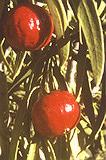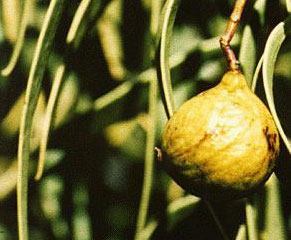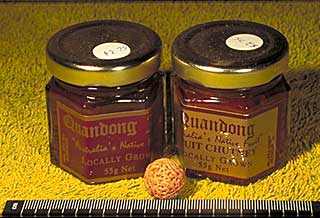|
[Front Page] [Features] [Departments] [SGAP Home
Page] [Subscribe]

Quandong
Santalum acuminatum....[Native Peach - Sweet
Quandong]
Horst Weber
Arkaroola is a private nature reserve in the Flinders Ranges of South Australia. Covering over 587.9 square kilometres the reserve is located in a semi-arid region about 600 km north of Adelaide, South australia's capital. The dramatic landscapes of the Flinders ranges are home to a wide range of plants, animals and birds. Among the plants to be found here is the Quandong (Santalum acuminatum), a fairly common plant of inland Australia and one of the few Australian native plants to be exploited for its food value.
| Santalum |
from Greek "santalon" and Arabic
"sandal", the Indian Sandalwood |
| acuminata |
Latin, meaning slender pointed |
So this plant is named after
the Indian Sandalwood
having slender-pointed leaves |
During the last 15 or so years the tree Santalum acuminatum has kept quite a number of scientists busy. Not only can its flesh be turned into nice jellies, jams and pies, it is also stuffed to the limits with Vitamin C and houses quite a number of valuable minerals. Furthermore, it may be dried and stored. The kernel contains valuable proteins and is rich in oil. The plant itself is not very fussy about different soil conditions and climates, nor about water quality. It is therefore, in economical terms, a potentially valuable plant which can be grown in the drier parts of the country, too. However, trying to "domesticate the quandong", as one scientist [King, L., 1981, p.38] put it, is not all that easy.
 |
Santalum acuminatum, shining with ripe red fruit in September. Select the thumbnail image or plant name for a higher resolution image (42k).
Photo: H.Weber.
|
First, there is the problem of where to start an orchard. This may sound a bit odd. After all, we know that the plant tolerates a wide variety of climates and soils. Unfortunately soil is not all. Quandongs are partial parasites. They feed themselves not only from their own roots. In order to gain all the nutrients they need they grow sucker-like attachments onto the roots of other plants and simply take what they can get. They are not very choosy about their host plants as long as the host`s roots provide what the quandong needs. So, any commercial enterprise intending to start a quandong orchard will need a location which provides a good number of other plants, too.
 |
The ripe fruits of the quandong
tree. Select the thumbnail image or highlighted word for a higher resolution image (28k).
Photo: H.Weber.
|
Second, there is the problem of seed germination. If kernels or seeds are undamaged, they are apparently difficult to germinate. However, once damaged there is the risk of infections by fungi. The solution to this problem may lie in a chemical treatment with substances by the name of gibberellins, combined with vacuum infiltration. The gibberellins enhance the germination process and the vacuum infiltration appears to be a very effective way to deal with the kernel.
| |
 |
| |
A single fruit, not yet ripe,
gently drooping amidst the leaves. Photo: Horst Weber
|
Various ways of infiltrating the seeds with the chemicals, like leaching in water, cracking, heat, have been studied and comparing the results, the best method seems to be a vacuum infiltration. I am, however, not sure how far this scientific research of 1994 has filtered down to commercial application by now.
It will come as no surprise that the usefulness of the plant did not go unnoticed with Aborigines and early white settlers, who used it as a welcome source of food. Its vernacular name sweet quandong, by the way, was a means to distinguish it from the bitter quandong S. murrayanum. The attractive kernels could be made into necklaces and nice ornaments and were useful as marbles for games such as Chinese checkers.
Within the area of the Arkaroola-Mount Painter Nature Sanctuary, there are a number of places where Santalum acuminatum trees are growing. The individual plant at the very top of Arkaroola`s Surveyor`s Cairn Track, only a short walk from the village, is unfortunately not the most glamorous of its species. However, in other areas of the Arkaroola Sanctuary, during the months of August/September, I have stumbled upon beautifully grown trees, laden with shining red Quandong fruit, decorating the proud plant like a Christmas tree.
| Annual Mean Temperatures (C°) |
| Minimum | Maximum |
| 3 °C | 38 °C |


Description
Characteristics of Santalum acuminatum
| Plant | Spindly shrub, shapely tree up to 5 m tall, drooping branchlets, bark light brown, slightly furrowed |
| Leaves | Growing Pattern |
Opposite, with short stalk |
| Colour | Light-green, olive green |
| Size | 5-19 cm long, 4-15 mm wide |
| Shape | Lance-shaped, often curved, tapering to a curved point, older leaves often thick |
| Surface | Older leaves have prominent veins |
| Flowers | Time |
Mainly Oct. - May, but also throughout the year |
| Growing pattern | In short, pyramid-shaped panicles (loose, irregular kind of an arrangement of flowerheads) at the end of
branchlets |
| Colour | Whitish or cream |
| Size | Panicles shorter than leaves,
individual flowers approximately 2-4 mm long |
| Shape | Short panicles, each flower with 4 segments, which remain attached to the ripe fruit |
| Fruit | Time |
Usually around August/September |
| Colour | Red, when ripe; green or yellowish green before |
| Size | 2-5 cm diameter |
| Shape | Globular |
| Surface | Waxy, somewhat grooved |
| Other | Fleshy, with a large, deeply pitted stone |
Apart from Santalum acuminatum , two other members of the sandalwood family grow on Arkaroola territory. These are the native plum (S.lanceolatum) and the leafless cherry (Exocarpus aphyllus). All three species are root parasites, so they need to tap the roots of other plants in order to supplement the diet from their own roots. This is vitally important for young plants but even established and mature plants depend on this egoistic mechanism.
| |
 |
| |
Jam and chutney made from quandong
|
The fruit of all three plants are edible and the quandong, in particular, is receiving some degree of commercialisation.
The wood of the native plum gives off an aromatic scent when burnt, and is one member of the family which is commercially exploited for its scent. Its list of vernacular names, apart from native plum, includes names like plum bush, cherry bush, blue bush, bush plum, northern sandalwood, as well as sandalwood. However, it should not be confused with the main commercial sandalwood Santalum spicatum, a plant which to my knowledge does not grow at Arkaroola.
PLEASE NOTE: The evidence on vitamin C-content is contradictory: King, L., 1981, speaks of "... high vitamin C content ..." while Brand, C.J., et al, 1985, p. 61, does not list any vitamin C content at all.
References
- Black, 1957, Flora of South Australia, p. 275
- Bodkin, F., The essential reference guide to native
and exotic plants in Australia, p. 907
- Brand, J.C. et al, 1985, "The nutritional composition of
Australian Aboriginal food plants of the desert regions" in:
Wickens, G.E.
et al, pp. 61; 65f
- Cunningham, G.M., et al, 198, Plants of Western New South Wales,
p. 226
- Edmunds, L., et al, 1987, Flora List - Arkaroola Mt. Painter
Sanctuary, Northern Flinders Ranges
- Jessop, J.P., 1986, Flora of South Australia
- Johnson, Hugh, 1984, Hugh Johnson`s encyclopaedia of Trees, p.
328
- King, L. (Ed.), 1981, Alison Ashby`s Wildflowers of
Southern Australia, p. 38
- Loveys, B.R., et al, 1994, "Stimulation of Quandong
(Santalum acuminatum) and
other Australian Native Plant Seeds" in: Aust.J.Bot.42,
pp. 565; 567; 573
- Maconochie, J.R., 1985, "Plants of the Australian arid
zone - an undeveloped
potential" in: Wickens, G.E. et al, p. 297
- Smith, N.N., 1991, "Ethnobotanical field notes from the
Northern Territory" in: J.Adelaide Bot.Gard.14(1) , p. 51
- Wickens, G.E., et al, 1985, Plants for arid lands, pp. 61;
65f; 297
Horst Weber is a teacher and IT-manager at the German Cultural Institute, or "Goethe-Institut", Dublin. Ten years ago, on his first visit to Australia, he fell in love with the private nature sanctuary, Arkaroola-Mt-Painter in South-Australia. He his presently (September 97) at the Sanctuary, putting the finishing touches to a small book about some of Arkaroola's common bushes and trees. The above article on Santalum acuminatum is one text from the book.
Should you be interested in further information, you may contact Horst by email - hweber@indigo.ie or by snailmail - Horst Weber, 9 Fitzgerald Street, Harold's Cross, Dublin 6, Ireland
 [Front Page] [Features] [Departments] [SGAP Home
Page] [Subscribe]
[Front Page] [Features] [Departments] [SGAP Home
Page] [Subscribe]
Australian Plants online - September 1997
The Society for Growing Australian Plants
|